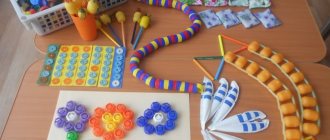Development of fine motor skills in children 4-5 years old
The same exercise can be performed by turning one hand with the back of the palm facing up.
You can perform leg exercises while sitting on a chair.
"Be healthy"
Place the ball on the floor. Place one foot on top of the ball. The other leg is firmly on the floor. Sit up straight, press your back against the back of the chair. Roll the ball back and forth with your foot, slowly. Then, the same movement is performed with the other leg. This exercise can be performed with both legs, rolling the ball alternately, or with both legs at the same time. Alternatively, you can make circular movements with one leg, then the other. The exercise is performed at a slow pace with a good range of motion. The exercise can be performed with both legs at once, either alternately, or with both legs at the same time.
"Slide"
Take off your shoes. Sit on a chair. One leg stands firmly on the floor, and the other is straight forward, toes extended. Take the ball in the hand opposite to your outstretched leg. With this hand, begin to lift the ball up your leg. Cover the ball with your hand and hold it for a count of 5, then “lower” it down the slide. Repeat the same exercise with the other leg. Then increase the count to 10. The exercise is performed slowly, with a good range of motion. Exercises for children 6-7 years old
"Soldiers"
Press both hands tightly towards you with your elbows. Take the ball in one hand. Perform circular movements first with one hand, then transfer the ball to the other hand and perform the same exercise. Perform movements slowly, without rushing. Circular movements are performed towards and away from yourself. When the child learns how to perform the exercise correctly, the tempo can be increased. Make sure that the child does not raise his shoulder. When the child learns how to perform the exercise correctly with one hand, you can ask him to perform the same exercise with both hands at the same time.
"Training"
Place both hands on your elbows and press them tightly to you. Take the ball in one hand. Perform back and forth movements with your hand, then transfer the ball to the other hand and perform the same exercise. Perform movements slowly, without rushing. When the child learns how to perform the exercise correctly, the tempo can be increased. Make sure that the child does not raise his shoulder. When the child learns how to perform the exercise correctly with one hand, you can ask him to perform the same exercise with both hands alternately or simultaneously. When performing some exercises, you can place your hands on the table. The height of the table should be such that the child sits straight at the table without hunching over.
Hand massage
Finger massage is very useful for a small child. For the development of speech, attention and fine motor skills. Thanks to finger games, creativity and reaction speed develop, children better learn concepts such as “above”, “below”, “left”, “right”, learn to count, and simply improve their mood. Thanks to this massage, the “manual intelligence” located on the tips of the fingers and palms is activated. Regular repetition of exercises has a beneficial effect on speech, increases mobility and flexibility of the hands, which helps to successfully master writing skills.
HAND DEVELOPMENT NORMS
After 3 years, children’s motor skills become more complex and varied: the percentage of actions that require coordinated hand movements from the child increases.
What should children of this age be able to do in terms of developing fine motor skills?
- To hold objects, they increasingly use their fingers, rather than the palm, as before.
- Able to hold a pen or pencil.
- They can draw lines, circles, polyhedra, redraw crosses and squares.
- They know how to cut paper shapes with scissors.
- Can take off and put on clothes and shoes.
- Grab small objects or parts with your thumb and index finger.
- Build a tower with at least 3 cubes.
- Draw a person consisting of at least 3 elements (head, torso, limbs).
- Take out small objects from a transparent container.
- Unscrew the lids.
- String beads onto wire.
- They can draw with their fingers.
- Scoop the cereal into a spoon from one container to transfer it to another.
- Trace the outline along the dotted line.
- Simple elements are molded from plasticine.
- Fasten and unfasten zippers, clasps, snaps, buttons.
- Sorting small items and cereals.
- Unwrap candy wrappers.
- They tie knots.
- Hand movements occur through coordination with vision.
All these skills need to be developed and improved, preparing little hands for increasingly complex and precise manipulations.
If your baby does not yet know how to do something from this list, it is important to fill this gap in a timely manner. Teach him age-appropriate skills, otherwise he will have problems later: he will have to not only learn new skills, but also catch up with his peers where he lags behind. And this is more difficult.
Games for the development of fine motor skills in the second junior group
Games that promote the development of a child's motor skills include the following types of entertainment activities:
- fingered. They are considered a unique way to develop children's speech. Along with the exercises, kids memorize texts, which helps develop attention, memory, imagination, thinking, reaction speed, expressiveness of emotions, etc.;
- origami. Creating paper crafts without using glue is the next option for developing motor skills, which can be interesting for both children and adults;
- lacing is a type of game that is not only useful for general development, but will also help the child in the future;
- games with cereals, sand, beads, bulk substances (stringing, transferring into containers, etc.);
- modeling from clay, dough, plasticine.
Dot drawing classes for preschoolers in kindergarten
EXAMPLES OF FINGER GAMES
So, the development of fine motor skills in children 3–4 years old begins with the simplest games:
- Actively rub your palms and ask your baby to do the same.
- Show your child how siblings greet each other - the fingers of the same name on your hands: touch each other alternately with your little fingers, ring fingers, middle fingers, index fingers and thumbs, telling your baby that this is how brothers greet each other. Let him try again.
- Let the baby imagine that his index and middle fingers are legs that are stomping along a path (for example, into the forest for sweet strawberries). His fingers should precisely walk along the surface of the table.
- And now let him turn into an old grandmother (grandfather) who cannot see well. The doctor prescribed glasses for them (the child uses his thumb and index fingers to pretend to be glasses, bringing them to his eyes).
A little later, when the baby gets used to such exercises, you can start playing with short rhymes, gradually adding longer rhymes and complex movements.
- boat
A hare is swimming in a boat (the child folds his hands in the shape of a boat),
The little bunny calls to swim with him (the baby waves his hands with inviting gestures).
- cat
How painfully does a baby cat bite?
He decided that he saw not a finger, but a mouse!
But I'm playing with you, baby,
And if you start biting, I’ll say: “Come on, shoot!”
When performing this game, the mother takes an old clothespin with a relaxed clamping mechanism so that it does not catch painfully, and “bites” each of the child’s fingers in turn.
- Curlers
The essence of this game is to bend each finger on the baby's hand in turn. To do this, you can use a variety of nursery rhymes. For example, these:
This finger is daddy.
This finger is mommy.
This one here is a grandpa.
This is grandma.
Well, this finger is me.
That's my whole family!
(You need to start counting with your thumb to finish with your little finger)
This brother found a fungus.
It began to cut him.
It was my brother who was frying a mushroom.
This one just ate and ate,
Look how fat he has become!
(Counting, on the contrary, starts with the little finger and ends with the thumb).
Peculiarities
In preschool age, motor skills normally become more diverse and complex compared to 2-3 years of age. The proportion of manipulations requiring coordinated hand actions is increasing. You need to know what age-related characteristics characterize the development of fine motor skills in children 4-5 years old in order to direct it in the right direction.
- By the age of 3, children’s finger movements become at least somewhat similar to the movements of an adult.
- Fine motor skills previously acquired are improved.
- Children learn to put things in a certain place.
- Until the age of 3, the baby grasped and held mainly with his palm, but now he uses his fingers more actively.
- Preschoolers from 3 to 5 years old try to draw circles and lines, cut paper with scissors, take off and put on loose, loose clothes.
- Fine motor skills are now being developed in conjunction with the kinesthetic sense. The child begins to become aware of the position and movement of his own body in space. The process of development of visual-tactile-kinesthetic connections starts. Thanks to this, hand movements are performed under visual control.
Thus, the development of fine motor skills of the hands in children 3-4 years old occurs sequentially, gradually. First you need to learn how to reach out to grab an object, and then manipulate it. Coordination of the movements of both hands and eyes is important in this process. Teachers, psychologists, and physiologists have determined the norms and deviations in the development of fine motor skills in preschool age.
Deviations
If the development of fine motor skills in children 3-4 years old is insufficient for this age, the child will experience characteristic deviations from the norm:
- movement technique is impaired;
- motor qualities suffer: agility, speed, strength, coordination, accuracy;
- psychomotor deficiencies are diagnosed;
- poorly formed basic self-service skills;
- poor technical skills in drawing, modeling, design, appliqué;
- inability to hold a brush or pencil correctly and regulate the pressure on them;
- difficulty using scissors.
If the development of motor skills in children 4-5 years old occurs according to this plan (5-6 violations), these are deviations. Despite the absence of gross motor disorders, the level of physical and motor progress is much lower than that of normally developing preschool children. And here it is very important to recognize this in time.
Diagnostics
To identify that the development of fine motor skills in children 3 years of age and older is impaired, diagnostics is needed. A specialist will tell you the exact results, but it can also be done at home. Ask your child to do the following simple exercises.
- Read him a nursery rhyme while performing simple movements with your fingers and hands, and then ask him to repeat them after you.
- Extend your arms in front of you. One hand is clenched into a fist, the other is straightened. You need to slowly but simultaneously change the position of your hands.
- He should be able to “walk” along a flat surface with his fingers (index and middle fingers alternately).
- He should be able to “bend his fingers” one by one, starting with the little finger.
- Ask him to do the pinch-palm exercise. It is proposed to join the fingers of the left hand in a pinch as if it were depicting the beak of a woodpecker, and tap on the right palm, which should be vertically open. Do the same, changing hands.
- Ask to unfold both hands at the same time in a strict sequence: fist - edge of the hand - palm.
- In front of the child, disassemble the pyramid and give him the task of putting it back together.
- A similar exercise with a nesting doll: first they take it apart in front of him, and then ask him to put it back together.
- Ask to draw a house consisting of ordinary elements that are easy to reproduce even without the talent of an artist. Check how accurate the copy you receive is. Pay special attention to such small elements as a porch, a pipe, a door - they will indicate the dynamics of development in the hands of fine motor skills.
- Offer to trace the drawing point by point, but discuss in advance that you cannot tear the pencil (pen, felt-tip pen) from the paper.
- You need to shade the figure with straight lines, while trying not to go beyond its contours. Ask your child to use different types of shading: horizontal, vertical, diagonal, wavy.
Now take stock. If at 3 years old he is allowed to perform at least 30% of all these exercises, then by 5 years old fine motor skills should be so developed that 80-90% of these tasks are considered the norm. If your indicators are lower, you need to work more with your baby. Otherwise, this will then have a disastrous effect on his further speech and even intellectual development.
The most important factor that determines the development of fine motor skills in children 3 years of age and older is timely organized assistance of a correctional and pedagogical nature. Children with disabilities should be sent to correctional groups at specialized kindergartens. To prevent this from happening, parents should work with their preschool child as much as possible, developing fine motor skills in the fingers: there are a lot of techniques and methods.
How to develop fine motor skills in children 3–4 years oldconsultation (younger group)
How to develop fine motor skills in children 3–4 years old
A pressing problem in our time is the full development of children from preschool age. An important role in the success of a child’s intellectual and psychophysical development is developed fine motor skills.
Fine motor skills of the hands interact with such higher mental functions and properties of consciousness as attention, thinking, imagination, observation, visual and motor memory, and speech. The development of fine motor skills is also important because the child’s entire future life will require the use of precise, coordinated movements of the hands and fingers, which he needs to dress, draw and write, as well as perform other various everyday and educational activities.
A child's thinking is at his fingertips. What does it mean? It has long been proven that the development of speech and thinking is closely related to the development of fine motor skills. A child's hands are his eyes. After all, a child thinks with feelings - what he feels is what he imagines. You can do a lot with your hands - play, draw, examine, sculpt, build, hug, etc. The better the motor skills are developed, the faster the child adapts to the world around him!
All scientists who study the activity of the children's brain and the psyche of children note that in children the level of speech development is directly dependent on the degree of development of fine movements of the fingers.
To develop fine motor skills, you can use various games and exercises.
1. Finger games are a unique means for developing a child’s fine motor skills and speech in their unity and interconnection. Learning texts using “finger” gymnastics stimulates the development of speech, spatial thinking, attention, imagination, and develops reaction speed and emotional expressiveness. The child remembers poetic texts better; his speech becomes more expressive.
2. Lacing is the next type of toy that develops hand motor skills in children.
3. Origami - paper construction - is another way to develop fine motor skills in a child, which, moreover, can also become a truly interesting family hobby.
4. Games with sand, cereals, beads and other bulk materials - they can be strung on a thin cord or fishing line (pasta, beads, sprinkled with palms or transferred with fingers from one container to another, poured into a plastic bottle with a narrow neck, etc.
You can also use the following to develop fine motor skills:
• games with clay, plasticine, dough. Children's hands work hard with such materials, performing various manipulations with them - rolling, crushing, pinching, smearing, etc.
• drawing with pencils. It is pencils, and not paints or felt-tip pens, that “force” the muscles of the hand to strain, to make efforts in order to leave a mark on the paper - the child learns to regulate the pressure in order to draw a line of one thickness or another, coloring.
• mosaics, puzzles, construction sets - the educational effect of these toys cannot be underestimated.
• fastening buttons, “Magic locks” - play an important role for the fingers.
Systematic work in this direction makes it possible to achieve the following positive results: the hand acquires good mobility and flexibility, stiffness of movements disappears, pressure changes, which in the future helps children easily master the skill of writing.
Tips for parents:
1. Don’t overload your child, don’t try to give him everything at once! Much does not mean good!
2. Do not interrupt classes for a long time.
3. If the child is not interested in an activity, it is better to postpone it or replace it with another.
4. Don't try to get results right away. Even if something didn’t work out, what is important is not the result, but his participation and the experience gained (even the experience of failures).
5. Don’t do anything by force! Classes should bring him joy and desire.
6. Spare no expense on quality materials and equipment.
7. Come up with stories in advance, using the child’s existing experience (fairy tales, poems, trips to the zoo, theaters).
Material from the site https://www.maam.ru/







